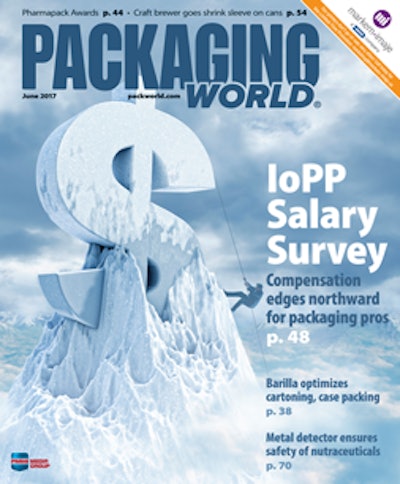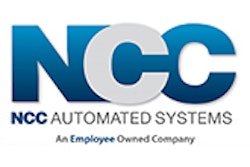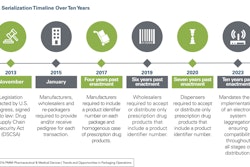The saying, “Slow and steady wins the race,” is associated with Aesop’s “The Tortoise and the Hare” fable. Yet, it’s also applicable to total compensation, as reported by packaging professionals responding to the annual Salary Survey.
Results from the 2017 survey, which examine annual compensation earned in 2016, reveal that the weighted average of combined salaries, incentives, bonuses and commissions for U.S. respondents increased 3.9% overall to $119,710. But the past year’s gains weren’t enjoyed by all.
Conducted by the Institute of Packaging Professionals and Packaging World magazine, the 2017 Salary Survey was developed in cooperation with Gros Executive Recruiters, with Kane Consulting tabulating and summarizing the results.
An important differentiation is that these total compensation figures represented domestic responses only. Respondents from foreign countries reported an average income of $88,420. Weighted total earnings overall, including foreign and domestic respondents, were $116,910, up from $112,720 in 2015.
Although overall incomes grew modestly from last year’s numbers, workers in the 18 to 24 and 25 to 34 age groups enjoyed a boost of more than 11% in this latest survey. On the other end of the financial spectrum, 35 to 44-year-olds reported pay cuts averaging 3.7%.
This year, 64% of respondents expected to earn more than last year, with 28% believing they’ll earn the same income this year. Only 8% anticipated earning less in 2017 than in 2016.
With incomes moving in a positive direction, 71% of respondents felt either somewhat or very secure regarding job security satisfaction. Only 15% said they were either a little worried or very worried. During the past year, 85% remained at their current job. Of course, job stability projections are also dependent upon national and global geopolitical market complexities.
Overall job security was reflected in that only 25% of respondents will possibly seek a new position in 2017. Only 13% said they were either currently looking or definitely looking for a new job. In another telling sign: In 2016, 85% of respondents reported they did not change jobs.
Among some of the survey information nuggets were the following:
• Corporate management incomes were at the top of all job function categories at $169,025, with structural design pros at the lower end at $77,632. Purchasing and production functions enjoyed the greatest income gains from 2016 to 2017, rising 16.6% and 15%, respectively.
• A considerable gender gap existed among this year’s survey respondents. Here, males reported a rise in income of $5,000 from 2016 to $121,773 in 2017, while females experienced an average drop of $386 to $98,956 in 2017.
• A huge income discrepancy in educational experience was shown, with pros earning a post-graduate or PhD degree reporting a 27.6% leap to $128,839. Meanwhile, high school grads acknowledged incomes sank 14.3% to $87,059.
• Packaging workers reaped financial benefits in the past year regardless of whether they worked with an end-user or supplier firm. Supplier pros reported average earnings of $130,080 (a 4.2% increase from the previous year), compared to $114,446 (up 5.3%) for end-user employees.
• Among respondents, 41% worked for a company that sold food products/services, followed by 28% selling medical products, 26% pharmaceuticals, 26% beverages, and 25% cosmetics/personal care offerings. For this question, respondents could select multiple goods and services.
• Engineers, at 32%, made up the bulk of survey respondents, followed by R&D (19%), marketing/sales (15%), and corporate management (11%).
Respondents express job needs
The survey asked respondents, “What do you feel is the ONE thing you need to make you a better packaging professional?” Many respondents sought additional educational and training opportunities, greater management communication, and often more time and resources to complete projects. Among the responses were the following:
“Keep up to date with the latest developments in terms of packaging design, materials, and equipment so I can implement new ideas at my job.”
“Greater visibility on the industry landscape globally (challenges, opportunities, and regulatory changes).”
“A more well-rounded education in multiple industries around packaging—logistics, distribution, supply chain, marketing, and purchasing.”
“Better understanding of the labeling regulations for medical and pharmaceutical products.”
“More job opportunities for highly experienced packaging engineers.”
“Need to understand the end-user requirements, product protection, machinability, and regulations for new product development.”
“More exposure to trade shows and conferences to keep up to date with new and emerging technologies.”
“Additional knowledge in sustainability and innovation as they apply to my specific packaging field.”
“Better IT tools that cross responsibilities and divisions; better resources—more staff, time, and project communications.”
“More opportunities to benchmark other professionals and how they have solved various packaging problems.”
“Make more connections to others in my industry outside my current company to share experiences and expand my knowledge.”
“Lateral thinking, meaning the ability to apply technologies from other industries to packaging.”
“Getting back into the workforce—lots of interviews but nothing has stuck so far.”
“With digital printing and technology advancements, I would like to be able to better prepare myself to be on the forefront of the changes.”
“Management support. That only comes through education of my managers, and that depends on how receptive they are to learn, so documentation is key.”
“Better purchasing support to keep costs competitive.”
“An online library of technical materials and guides. My background isn’t packaging, and there aren’t enough online resources with quick and easy access.”
“Management recognition that experienced packaging specialists are not just another easily replaceable ‘human resource’ but are knowledge bases in themselves.”
“A better understanding of the various equipment used in the industry and how they are categorized by both [their] manufacturers and end users.”
Salary Survey reveals ‘compensation highlight awards’
A clever perspective based on takeaways pertaining to packaging compensation and job issues follows, from Dennis Gros, President and founder of Gros Executive Recruiters:
What not to do award: Become a consultant. Compensation was down 13.3%! How did we get so many consultants? Corporate managers looked at a meager 1.8% compensation increase, and decided to quit their jobs and become self-employed.
Go large or go it alone award: Packaging employees of companies with less than 10 employees saw a 10.2% increase in compensation. Employees of companies with more than 50,000 employees enjoyed a 10.1% increase.
The we made more award: Goes to production employees, who achieved an increase of 15% in this year’s survey. How? They made more money by making more stuff.
The move south award: In our recruiting work, we often discuss relocation with candidates. Lately the area in highest demand is the South Central region, citing temperate climate and lifestyle issues. But the region also seems to pay off financially, as packaging professionals in the South Central reported a 20.8% increase in compensation.
The credentials award: Goes to packaging professionals with advanced degrees, who reported 27.6% higher earnings in the 2017 survey. Unfortunately, many had to use the raise to repay their student loans!
The bright eyes and open minds award: Goes to workers in the categories of 3-5 years and 6-10 years of experience, who reported income increases of 10.6% and 13.0%, respectively. Those just ahead of them in seniority, with 11-15 years of experience, paid for it, because they reported a decrease in compensation of 2%.
Three key predictions for 2017
Gros also analyzed three key factors to watch for in today’s job market:
1. Art becomes task. As gray hairs retire, they will be replaced by short-tenure Millennials who are emotionally detached but equally effective in jobs that can be condensed into a series of tasks. How? Step-by-step apps will guide new workers though the intricacy of each task. Management will need to create the process flow diagrams that will enable on-the-job training.
2. The year of the raise. The year 2017 will see job growth accelerate faster than the number of people who are available for the jobs. Expect to see upward pressure on salaries in the fourth quarter.
3. Ping pong? Grow up! Game rooms will shrink or disappear from trendy employment cocoons. Employees want money instead.


























